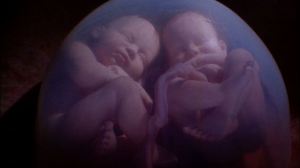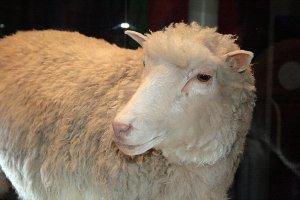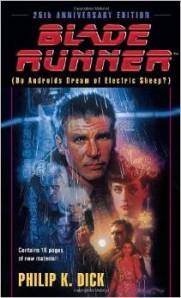What would the world feel and look like to you if you had another existing you or many of the same exact you to see? My mom is an identical twin which is a natural form of human cloning which happens when the fertilized egg forms one zygote which splits and forms two embryos. Monozygotic or identical twins are genetically nearly the same but are not genetically exactly the same. Identical twins do not have the same fingerprint since they move around in their environment in the womb differently. They don’t express the same phenotypes which are observable traits expressed by the genes of the individual. The phenotype is controlled by the genetic make-up of the organism and the environmental pressures the organism is subject to which will be different for both of the individuals. These different environmental influences can cause genes to be turned on or off or partially turned on or off which makes the identical twins not exactly the same.
Human cloning is the creation of a genetically identical copy of a human. The term is generally referred to mean artificial cloning which is the reproduction of human cells and tissue. It does not refer to the natural conception and delivery of identical twins. There are two types of theoretical human cloning which are therapeutic cloning and reproductive cloning. Therapeutic cloning involves cloning cells from a human for use in medicine and transplants. There are two common methods of therapeutic cloning which are being researched now which are somatic-cell nuclear transfer and pluripotent stem cell induction. The somatic-cell nuclear transfer(SNCT) is a laboratory technique for creating a viable embryo from a body cell and an egg cell. In this technique, you take an enucleated oocyte (egg cell) and implant it with a donor nucleus from a somatic (body) cell. This process is used in both therapeutic and reproductive cloning. Dolly the Sheep was created in 1996 using the somatic-cell nuclear transfer reproductive technique and was the first successfully cloned mammal. Several other mammals have been successfully cloned since then as well. Pluripotent stem cell induction is when cells can be generated directly from adult cells which can form every other cell type in the body such as heart, neuron pancreatic, and liver cells which could be beneficial for regenerative medicine. This technique has a well-known pluripotent stem cell which is the embryonic stem cell. The generation of embryonic stem cells involves destruction or at least manipulation of the pre-implementation stage embryo and has been the basis of much controversy.
“What do you think or make of the cloning of animals?” “How do you feel about cloned animals being a part of our food supply?” “Would you want to eat steak or a hamburger from an animal that has been cloned?” “Would you like to see a human become cloned like what happened in the Doctor Who: “End of Time (Part One)” episode?”. Being John Malkovich is another good example of seeing massive human cloning. It gave me an uncomfortable feeling seeing so many of the same individual. I felt like it was a loss of genetic diversity. I think human beings in themselves like to see diversity in our society and see people being a “unique” being created naturally instead of an “artificially developed” being. When I see the word artificial on food labels it bothers me and then when it comes to reading and thinking about it concerning humans or animals reproductively then it bothers me even more. God created a natural way of life and I feel that we need to be careful of what we are creating on the scientific home front. “Will there be a loss of personality when you clone artificially?” A person is developed naturally by combining a sperm cell and an egg cell versus in artificial cloning you have a somatic body cell and are taking the nucleus out of the somatic cell and placing it inside an egg cell.
I became fascinated and cautious in my mind about the idea of cloning when I saw the movie Blade Runner which was based from Philip K. Dick’s novel Do Androids Dream of Electric Sheep? The movie is about human replicants or clones. The movie touched on important aspects of these individuals like if they had feelings or not or memories of their childhood being in their mind or absent. The human replicant was only produced to act as slave labor in an off-world for so many years and then their time would be up. “Would the replicants pose any real kind of threat to anyone else?” This movie really made me think about the ethics behind cloning. Another example of a science fiction movie that brings cloning into the forefront is in Star Wars Episode II: Attack of the Clones. Obi-Wan Kenobi finds out about the Republic’s sinister plan to build a clone army using bounty hunter, Jango Fett as the template. Again, using these clones in a defense only lifestyle such as the army makes you wonder if they will have emotions about their lives and how they were created. The fact is their lifestyle was chosen for them by the Republic and not by them. That is where the ethics question of cloning comes in for me on whether it is ethical or not. I believe that human cloning is ethical if used for therapeutic purposes but unethical for reproductive purposes. Concerning the therapeutic, it would be incredible and beneficial if scientists found cures for the diseases through somatic-cell nuclear transfer(SCNT) but as for reproductive cloning then I think we are heading for a battleground when it comes to that technique of cloning. Let me know what your thoughts are about this topic.







I’m not sure the world could handle two of me *lol*.
LikeLiked by 1 person
What Sam! I think the world would be cool if it had two of you in it! 🙂
LikeLike
I learned something about identical twins–they are not exactly genetically identical, just nearly identical. Good essay bout human cloning. Thanks.
LikeLiked by 1 person
Mom, I am glad that you learned something new about being an identical twin and human cloning from my article. Also, I am glad that you enjoyed reading it! 🙂
LikeLike
I cryo-preserved my stem cells from my first pregnancy, in case advances are made and a family member needs a donation. It was expensive, but well worth piece of mind. Hopefully, even if we never use them, they can be generationally transferred via Will and Testament to another generation. So science marches on…right.
LikeLike
Sue, that is awesome that you did that! 🙂 That was a beautiful thing you did for your family!
LikeLike
Great read. Thanks Jennifer..:)
LikeLike
Thanks so much, Pat! 🙂 I am glad that you enjoyed it! 😉
LikeLike